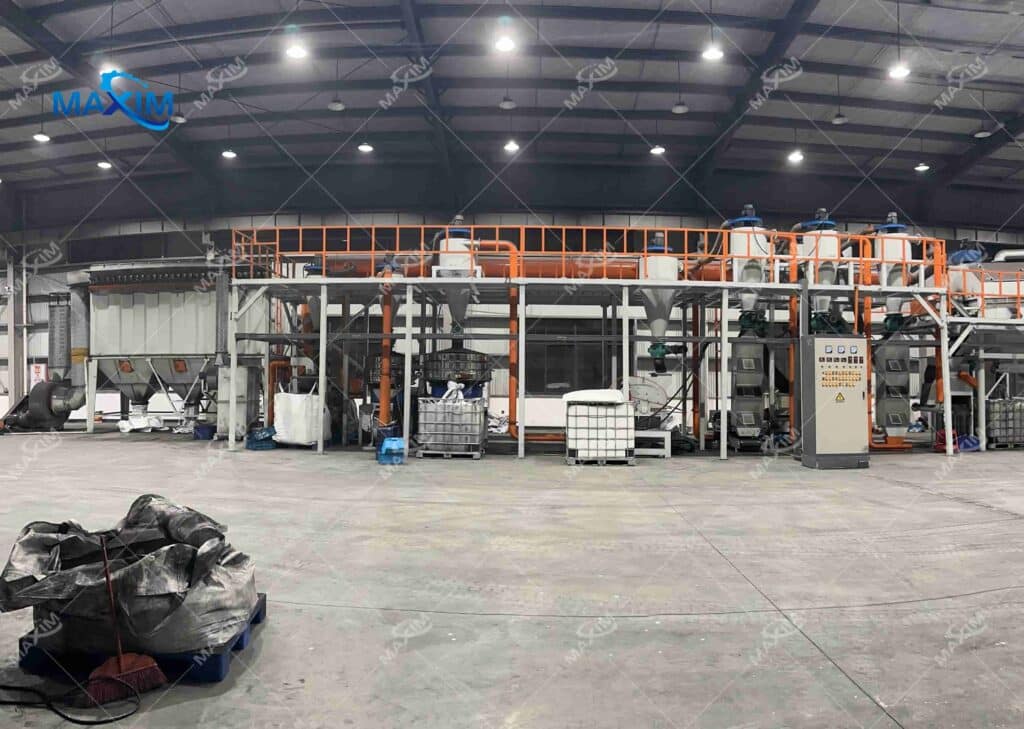
With the number of new energy vehicles exceeding 30 million and the accelerated deployment of energy storage power stations, millions of tons of used lithium-ion batteries are forming a large “resource pool” and “pollution source” each year. As traditional processing methods face efficiency bottlenecks and environmental pressures, our intelligent lithium-ion battery disassembly and powder production line is taking a comprehensive approach.

Resource Recycling Upgraded
No manual disassembly is required; aluminum-cased batteries are directly fed into the shredder, which coarsely crushes them into 30mm chunks. The dual-shaft crusher further reduces them to 5mm particles, and the vortex grinder grinds them into 0.5mm powder. The intelligent sorting system then achieves precise separation. Test data shows that copper and aluminum separation purity reaches 98% and 99.1%, respectively, with black powder recovery rates consistently above 98%. This equates to extracting 15kg of lithium salts, 8kg of cobalt metal, and 35kg of nickel metal per ton of waste batteries processed.
Compatible with all types of lithium batteries
The system integrates magnetic separation, AI visual recognition, and density air separation technologies, with 32 built-in battery processing models. Whether it is ternary lithium batteries, lithium iron phosphate batteries, or consumer lithium batteries, all can be processed and utilized through the production line.
Green energy closed-loop
In a low-temperature environment, battery separators and electrolytes are converted into combustible gases through pyrolysis, which are then incinerated in an RTO system to generate steam for drying. Test results show that processing 10,000 tons of batteries can recover 1.2 million kWh of thermal energy, equivalent to reducing coal consumption by 400 tons, achieving a complete “resource-energy-reuse” cycle.
Strictly Adhering to Green Standards
The production line adopts a sealed negative pressure design, combined with a three-stage dust removal system (cyclone dust removal + filter cartridge dust removal + activated carbon adsorption), keeping the workshop dust concentration stably controlled at 8 mg/m³, exceeding the national standard (10 mg/m³). Exhaust gases are treated via RTO incineration + alkaline solution spraying, with non-methane total hydrocarbon emissions <10 mg/m³.
Chosen by clients from multiple countries
The production line has been implemented in 15 countries, including domestic lithium battery industry clusters (Jiangxi Yichun, Hunan) and Southeast Asia (Malaysia, Thailand), as well as Europe (Poland, Germany). From laboratory research to industrialization, from domestic to international markets, this production line, which incorporates a decade of R&D experience, is providing a solid foundation for the sustainable development of the new energy industry. Start collaborating now to transform waste batteries into green energy and gain a competitive edge in the circular economy!
If you are interested in learning more details, we warmly invite you to visit our company for an on-site tour. We offer free transportation and dedicated service staff to assist you. We look forward to your visit!
Global Sales Hotline: WhatsApp: +8618530909622
Introduction Of Industrial Scrap Metal Shredders Industrial scrap metal shredders are vital for smooth metal recycling work. Whether you handle scrap steel, copper, or aluminum, picking the correct shredder affects your output, power use, and work safety. What Makes a Scrap Steel Shredder Efficient? A good scrap steel shredder gives high output with little energy excerpt …